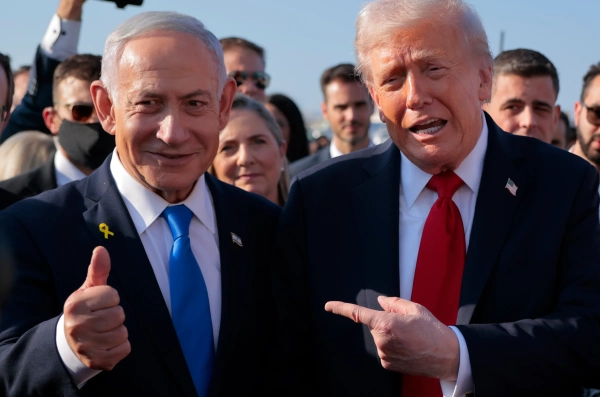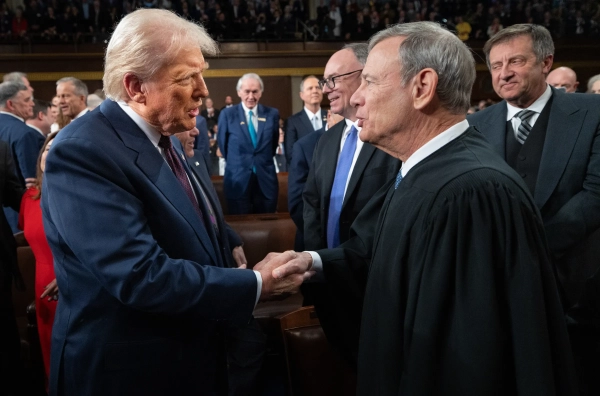
The cessation of hostilities between Israel and Hamas is still nascent and precarious, yet the disputes concerning who should be applauded for it — or who should be reprimanded for the delay in its realization — are already intense.
Did the recent strain exerted by President Donald Trump on Israeli Prime Minister Benjamin Netanyahu prove critical? Or was Trump’s backing of Netanyahu’s recommencement of the war earlier in the year the deciding factor, given that it compelled Hamas to concede further?
On the other hand, has Hamas been entirely amenable to an accord such as this for a year or more — implying Israel was the primary obstacle? Or did the newly amplified strain on Hamas from Qatar, Egypt, and Turkey in recent days goad the group into providing fresh compromises?
Does the fresh truce implicate President Joe Biden for insufficient pressure on Netanyahu? Or is the outcome essentially equivalent to the truce achieved in January while Biden was still in office — which would indicate Israel’s resumption of hostilities in March, with Trump’s endorsement, ruined that former accord for no justifiable cause?
Related
- What life has been like in Gaza since the ceasefire
- The greatest strength, and weakness, of the Gaza peace accord
All these competing interpretations are circulating, advocated by individuals with varying partisan, national, and ideological leanings.
However, upon closer examination, certain points of convergence emerge within these narratives — alongside some revealing inconsistencies.
Both Hamas and Netanyahu changed position on pivotal issues
For a prolonged duration of two years, sporadic ceasefire discussions have faltered (or have ultimately collapsed) owing to the inability of Israel and Hamas to concur on the scheduling and essence of several matters. Precisely when would Israel remove its armed forces and genuinely consent to cease hostilities? At what point would Hamas return the captives, and reciprocally for which Palestinian detainees held by Israel? What depiction would a postwar Gaza assume — and would Hamas be amenable to disarming and ceding authority to alternative entities?
Netanyahu’s detractors assert that he was the party that consistently dismissed or undermined endeavors to terminate the war. Hamas, they contend, has for a considerable time been inclined to release its remaining captives in exchange for Israel terminating hostilities, yet Israel persistently declined, for a lengthy span of two years, prioritizing continued assaults and immense hardship for Gazan civilians. This transpired, they affirm, partially due to Netanyahu encountering domestic strain from his far-right coalition allies, who possessed the power to depose him — and as a consequence of facing individual legal peril should he be ousted from his position. From this perspective, Netanyahu would solely consent to end the conflict if a more influential power — the United States — essentially compelled him.
Related
- Trump’s accord could represent a triumph for Netanyahu, irrespective of its ultimate success.
Netanyahu’s proponents, conversely, have posited that the war was intended to guarantee the non-recurrence of horrors akin to those of October 7, thereby fundamentally serving Israel’s paramount interests. An essential aspect of this, they maintained, was the removal of Hamas from governance and the disarmament of the faction. Absent the fulfillment of that objective, they insisted, no acceptable peace could be attained. It was Hamas that persistently rebuffed acceptance of this — and solely military attrition and defeat, coupled with the erosion of its foreign benefactors (notably Iran and Hezbollah), would induce Hamas to compromise.
While these accounts diverge in their emphasis, moral assessment, and allocation of blame, they concur on the pivotal premise: the war persisted for an extended duration predominantly as a result of Netanyahu anticipating that further Israeli military force in Gaza and elsewhere might pressure Hamas into conceding further or ensure their total defeat. To conclude the conflict necessitated a shift from either Netanyahu or Hamas — or both.
And in the lead-up to the ceasefire arrangement, both did indeed shift.
Hamas consented to liberate all remaining living captives without stipulating a schedule for a complete Israeli troop departure, a concession the group had long resisted. They acted according to that commitment: the captives have been freed, albeit subsequent to a partial Israeli troop withdrawal (Israeli forces continue to administer approximately 53 percent of Gaza; subsequent phases of the peace accord stipulate further withdrawals).
Netanyahu, meanwhile, gave his consent to the ceasefire despite Hamas’s incomplete defeat — and in defiance of his profound skepticism that Hamas would genuinely disarm and relinquish authority, as mandated by the pact. Indeed, Hamas’s endorsement of the arrangement contained several provisos, and this week’s occurrences involving Hamas militants publicly executing alleged collaborators in Gaza City have amplified reservations regarding the group’s dedication to demilitarization.
Why did Netanyahu shift?
Various accounts imply that a critical juncture in the negotiations was Israel’s failed strike against Hamas negotiators in Qatar last month, an event that appears to have significantly altered the dynamics of the war.
Beforehand, Netanyahu persistently expanded the war through audacious operations across the region, seemingly accruing success upon success: the assassination of a Hamas leader within Iran, the pager ambushes and strikes targeting Hezbollah, and the “12-day war” against Iran this past June.
However, the Qatar offensive signaled a cessation to this streak of accomplishment. It failed to eliminate its intended targets, and only achieved the result of thoroughly enraging Qatar, other Gulf states — and, crucially, Trump.
Eight months prior, during the transition departing from the Biden administration, Trump assumed a role in formulating what materialized into a transient ceasefire accord. Subsequently, upon Netanyahu’s abandonment of the ceasefire in March, Trump supported him, bestowing upon him unfettered discretion, and even participating in Israel’s incursion into Iran.
It transpired, nevertheless, that the Qatar incursion was a step too far for Trump, considering his amicable relations with the Gulf states and his stakes (both diplomatic and monetary) in the region. Rather than undermine Hamas, the assault appears to have spurred Trump to intensify his endeavors to bring the war to a resolution.
To accomplish this, Trump heightened the pressure on Netanyahu, exerting both public and private constraints. A source confided to Axios that Trump contacted Netanyahu, conveying that the Trump peace strategy was presented as a “take it or leave it” proposition — clarifying that “leave it means we walk away from you.”
This depiction casts Trump as resolute and definitive. However, was Trump genuinely prepared to retract his advocacy for Israel or its war, and was Netanyahu truly intimidated by his threats?
A contrasting interpretation suggests that, following two years of arduous conflict, Netanyahu, along with his country, stood poised to conclude matters. Through all those incursions — culminating in last month’s Qatar strike and the renewed offensive in Gaza City — Netanyahu assured Israelis, and particularly his far-right coalition associates, that he’d pursued the war as fiercely as anyone could desire. He is likewise able to assert that the war in actuality constituted a security achievement — given that it eliminated numerous Hamas commanders and significantly diminished the group while inflicting substantial blows against Hezbollah and Iran — in spite of the severe detriment to Israel’s global reputation.
Furthermore, Netanyahu’s advocates claim that the fresh ceasefire arrangement is in point of fact superior to any prior Hamas proposal — inasmuch as it secures the hostages’ return, whilst preserving Netanyahu’s latitude to reignite the conflict should Hamas fail to honor its obligations — possibly with backing from the US. (Trump cautioned Tuesday that should Hamas neglect to disarm, “we will disarm them.”)
Therefore, did this unfold solely due to Trump coercing Netanyahu, or as a consequence of Netanyahu’s preparedness, at this juncture, to accede to that coercion? We lack definitive knowledge, but evaluating this would be indispensable in gauging whether prior, more assertive pressure from President Biden might have effectively terminated the war much earlier.
Why did Hamas shift?
However, Netanyahu was not the sole party to shift, of course. Hamas also altered its stance.
Hamas’s negotiation approach had long been to insist on a complete and definitive cessation of hostilities before repatriating the remaining Israeli captives, as reported by Jeremy Scahill of Drop Site News. The group believed the captives afforded them vital leverage over Israel and resisted relinquishing that advantage.
In handing over all the captives promptly, Hamas sacrificed this bargaining power.
Indeed, Jared Malsin and Summer Said of the Wall Street Journal report that Hamas was fundamentally compelled by Qatar, Egypt, and Turkey to embrace an agreement the group opposed.
Citing “officials familiar with the discussions,” the Journal conveyed that the three nations threatened that should Hamas decline to endorse the peace accord, “Qatar and Turkey would cease hosting the group’s political leadership, and Egypt would discontinue advocating for Hamas to exert influence in Gaza’s postwar administration.”
Assuming the accuracy of this report, Hamas was placed under duress. Yet, their vulnerability to coercion stemmed from the tangible weakening of the group and its allies as a consequence of the war.
The assassinations of prominent Hamas figures and numerous rank-and-file combatants (alongside a substantial count of Gazan civilians), the decimation of Hezbollah, the implosion of Syrian leader Bashar al-Assad’s government, and the Israeli strikes within Iran collectively signaled that no relief force was forthcoming to rescue them — and that prolonging their resistance would only exacerbate their circumstances.
Hamas, therefore, conceded to relinquish the captives, and ratified a pact mandating their disarmament, despite reservations. And the global community will soon ascertain whether that accord endures.
Source: vox.com






